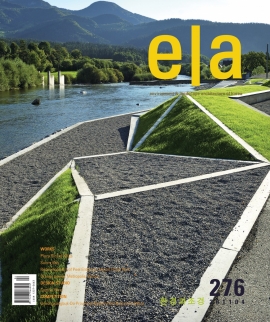Redevelopment of Peel Entrance,
Mount Royal Park
역사와 생태학의 통합
1874년 옴스테드(Frederick Law Olmsted)가 설계한 마운트 로열 파크는 연간 오백만 명 이상의 방문객이 이용한다. 이 공원의 복원계획 이전, Peel 섹터에는 부스러지는 벽체와 허물어진 계단, 진흙투성이의 좁은 길만 남아 있어 공원과의 연계가 취약하고 황량한 느낌을 주고 있었다. 그럼에도 불구하고 이 공원의 자연스럽고 그림 같은 경관은 여전히 옴스테드의 작품의 시적인 형태로 알려져 있었다.
옴스테드의 전통성을 유지한 채로, 이 산이 가진 고유의 특성들을 지역 재개발과 재설계에 이용하였다. 지질학적 및 수문학적 다양성과 식물의 다양성(풍부함)을 프로젝트에 담고 기존의 자연적이고 문화적인 요소들에 대한 세심한 관리를 시도하며 Peel 섹터가 도시와 견고하게 다시 연결되도록 하였다.
교통 관리
순환체계를 위한 구조적인 요소들은 옴스테드의 초기 계획안과 이용 햇수를 고려한 필요 노선들을 둘 다 만족시키고 있다. 이들은 Peel과 Redpath 진입부에 있는 두 개의 장엄한 입구에 대한 재정립, 옴스테드 길의 단면에 대한 개선, Serpentine 길의 재공사, 새로 만든 세 개의 계단들과 나무로 만든 거대한 계단참, 화강석 포장과 화강석 판석들을 포함하고 있다.
물 관리
복합적인 생태수문학적 물 관리 전략은 종다양성을 증진시키기 위해 생태계를 활성화시키며, 부지 내를 흐르는 풍부한 표면유거수를 조절한다. 상류 조절장치는 초당 50리터씩 전체 부지에 물을 흘려보내도록 제한하고 있고, 네 개의 습지는 식생과 야생 동물의 다양성을 증진시킨다. 습지대와 배수로는 표면 유거수를 모아주고 집수시설은 물을 배출구로 흘려보낸다. 이들은 모두 연결되어 일관성 있고 자율적인 수문 시스템을 형성한다.
Union between history and ecology
Designed by Frederick Law Olmsted in 1874, Mount-Royal Park has over five million visitors per year. Prior to its restoration, the Peel sector was desolate; a crumbling wall, a stairway in ruins, and muddy pathways; the link into the park was tenuous. Nonetheless, its natural and picturesque character were still informed by the poetics of Olmsted’s work.
In keeping with Olmsted’s tradition, the mountain’s own characteristics were tapped to regenerate and redesign the sector. Tying the project into the geological, hydrological and vegetative richness of the mountain firmly reattached the Peel sector to the city through the careful management of the existing natural and cultural elements.
Traffic Management
The structuring elements for circulation respect both Olmsted’s original layout and the desire lines imposed from years of use. These included redefining the two majestic gateways at the Peel and Redpath entrances, the remediation of a section of Olmsted Road, the reconstruction of the Serpentine path, three new staired pathways and numerous landings in wood, granite pavers or granite slabs.
Water Management
The complex eco-hydrological water management strategy controls the significant runoff through the site while developing ecosystems which encourage biodiversity. An upstream regulator limits flows for the entire site to 50 litres/sec, four wetlands encourage vegetative and wildlife diversity, swales and gutters intercept runoff, and catchment structures carry the water to the outfalls. The whole is linked together to form a coherent and autonomous hydrological system.
Forest Management
Raising the ecological value of the woods was the aim of the forest management practice. This included the regeneration of native shrubs, enhancing the avifaunal and micromamellian habitats, creating animal corridors, and insuring the safety of park visitors. This required considerable felling, pruning and planting to control invasive species and to open views towards the Saint Lawrence River and Olmstedian tableaus.
Artist Intervention
This work commemorates John Lennon’s famous bed-in with Yoko Ono in 1969 protesting the Viet-Nam war. At the base of a majestic rock outcropping, 180 rectangular limestone slabs are set flush with the ground carving out a retreat beside the upper curve of the Serpentine path. “Give Peace a Chance”, written and recorded during his Montreal stay, is carved in relief on 40 slabs in 40 languages, offering the public a universal and humanist vision to mirror Montreals cultural diversity.
Author _ Cardinal Hardy
Team _ Suzanne Rochon, Marie-Claude Seguin, Guillaume Vanderveken, Vanessa Parent, sabelle Giasson, Michele Gauthier
Collaborators _ Genivar, Denis Marcil ing. forestier, Linda Covit
Client _ City of Montreal
Location _ Montreal, Quebec, Canada





